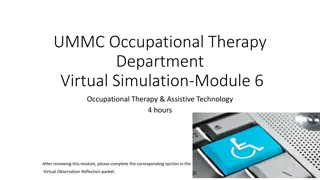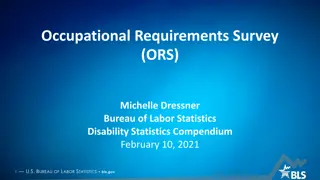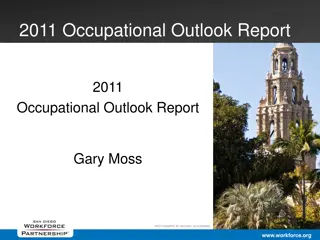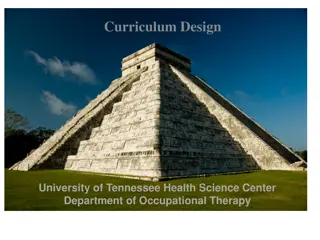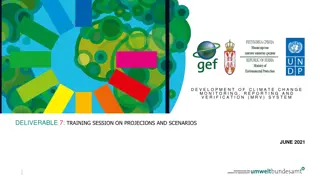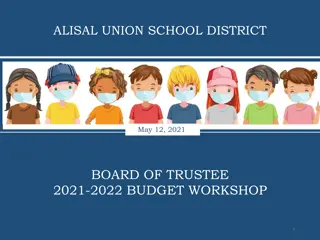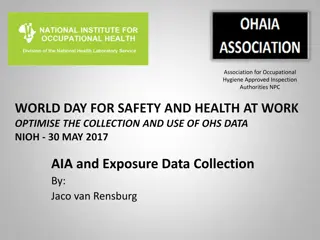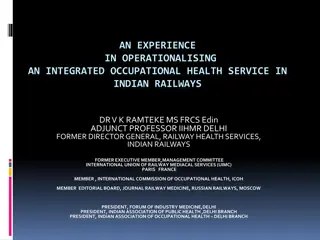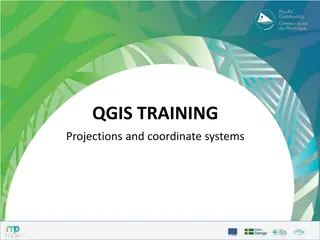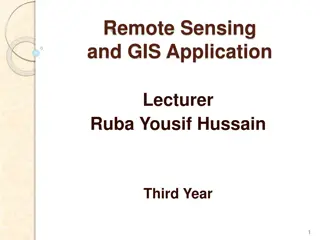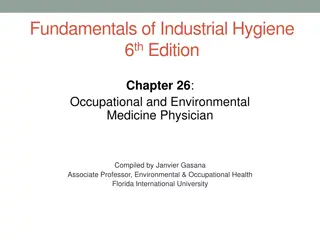Long-Term Industry and Occupational Projections 2016-2026
These projections by Paul Daniels, Statistician and Analyst at Virginia Employment Commission, outline the methodology changes towards separations-based estimations for workforce replacement needs, highlighting the evolution in workforce planning strategies over the years.
Uploaded on Feb 27, 2025 | 0 Views
Download Presentation

Please find below an Image/Link to download the presentation.
The content on the website is provided AS IS for your information and personal use only. It may not be sold, licensed, or shared on other websites without obtaining consent from the author.If you encounter any issues during the download, it is possible that the publisher has removed the file from their server.
You are allowed to download the files provided on this website for personal or commercial use, subject to the condition that they are used lawfully. All files are the property of their respective owners.
The content on the website is provided AS IS for your information and personal use only. It may not be sold, licensed, or shared on other websites without obtaining consent from the author.
E N D
Presentation Transcript
2016-2026 Long-Term Industry and Occupational Projections Paul Daniels, Statistician and Analyst Virginia Employment Commission
3 A Brief History of Industry and Occupational Projections TEGL 1-16 outlines the Virginia Employment Commission s need to produce state and local projections Funding provided by Workforce Information Grant Coordinated nation-wide by the Projections Managing Partnership Short-term (2 year) projections done annually Long-term (10 year) projections produced biennially Data sources: CPS, OES, CES, QCEW, LEWIS, BLS (National Change Factors and staffing patterns) Uses include: Development of high demand lists, training programs, funding requests, community development, industry development, business acquisition, and much more
4 New Methodology for 2018 Separations-based methodology implemented by the Bureau of Labor Statistics, ending use of Replacements methodology, in late 2017 Methodology began with statewide 2017-2019 short-term projections, and national 2016-2026 long-term projections Purpose (1): Estimate the need to replace workers who leave their occupation Purpose (2): Account for diverse job changes in an evolving workforce with low unemployment
5 Comparing Old and New Methods Separations Replacements Openings recorded when an individual of one age cohort leaves an occupation and is replaced by a worker from a different age cohort Assumes one occupation held throughout career Disadvantages smaller occupations Total Openings broken down to Replacements and Growth Openings recorded when a worker leaves the workforce, or transfers from one major occupation to another Accounts for career paths and a dynamic labor market Reflects potential for openings and replacements Total Openings broken down to Transfers, Exits, and Change
6 Replacements Versus Separations Allie: 44 year career, 4 openings created Bank Teller (5 years) Anthony: 44 year career, 1 opening created Short term job, with primarily one age cohort moving in and out College Student (4 years) Paper Route Accountant (8 years) HR Specialist (15 years) Primary Career Occupation held until retirement Replace by younger age cohort Financial Manager (12 years) Newspaper Journalist
8 Key Findings Fastest Growing Major Industries 2016 Base Employment 2026 Projected Employment Total Employment Change Industry Annual Growth Health Care and Social Assistance 441,229 554,380 2.31% 113,151 Professional, Scientific and Technical Services 409,398 482,019 1.65% 72,621 Arts, Entertainment, and Recreation Administrative Support and Waste Management Educational Services 54,776 62,677 1.36% 7,901 229,537 256,925 1.13% 27,388 354,347 395,780 1.11% 41,433
9 Key Findings, continued Fastest Declining Major Industries 2016 Base Employment 2026 Projected Employment Total Employment Change Industry Annual Growth Mining, Quarrying, Oil and Gas Extraction 5,756 5,205 -1.0% -551 Manufacturing 231,173 217,890 -0.59% -13,283 Information 67,902 66,875 -0.15% -1,027 Public Administration 59,188 59,044 -0.02% -144
2016-2026 Long-Term Occupational Projections Consider the Question
11 Top 10 Occupations by Projected Employment Annual Projected Employment Occupation Projected Employment Occupation Retail Salespersons 125,557 Registered Nurses 74,128 Cashiers 110,536 Janitors and Cleaners 73,134 Food Preparation and Service Workers 110,410 Personal Care Aides 72,069 General Office Clerks 89,036 Management Analysts 68,510 Customer Service Representatives Waiters and Waitresses 77,190 68,040
12 Top 10 Occupations by Annual Growth Rate Occupation Annual Growth Occupation Annual Growth Information Security Analysts Personal Care Aides 5.13% 3.53% Operations Research Analysts Home Health Aides 4.24% 3.16% Physical Therapist Assistants Physician Assistants 3.77% 3.10% Marriage and Family Therapists Nurse Practitioners 3.69% 3.03% Statisticians 3.67% Medical Assistants 3.01%
13 Top 10 Occupations by Annual Openings Occupation Annual Openings Occupation Annual Openings Cashiers 20,518 General Office Clerks 10,368 Food Preparation and Serving Workers 20,171 Janitors and Cleaners 9,646 Customer Service Representatives Retail Salespersons 17,972 8,766 Stock Clerks and Order Fillers Waiters and Waitresses 14,511 7,987 Personal Care Aides* 10,937 Laborers and Movers 7,506
15 In-Demand Skills by Occupational Dominance 2026 Projected Employment Projected Employment Difference Number of Occupations O*NET Skill Growth Active Listening 1,036,621 113,462 1.17% 184 Speaking 998,806 115,019 1.23% 182 Reading Comprehension 562,527 67,407 1.28% 153 Critical Thinking 415,907 58,828 1.54% 119 Writing 272,560 32,348 1.27% 79 Instructing 191,284 23,334 1.31% 51 Social Perceptiveness 378,701 45,090 1.28% 48 Judgement and Decision Making 213,180 32,095 1.65% 35 Learning Strategies 153,245 18,396 1.29% 33 Complex Problem Solving 95,061 13,437 1.54% 31
16 High Demand Skills by Growth Rate Projected Employment Difference 2026 Projected Employment Number of Detailed Occupations O*NET Skill Growth Active Learning 30,076 6,084 2.29% 23 Programming 61,823 11,884 2.16% 4 Mathematics 26,849 4,916 2.04% 9 Systems Evaluation 80,094 13,678 1.89% 3 Judgment and Decision Making 213,180 32,095 1.65% 35 Service Orientation 201,356 30,061 1.63% 17 Time Management 67,837 9,898 1.59% 9 Critical Thinking 415,907 58,828 1.54% 119 Complex Problem Solving 95,061 13,437 1.54% 31 Science 34,197 4,727 1.50% 31
17 Education-Based Projections 2016 Base Employment 2026 Projected Employment Employment Change Number of Detailed Occupations Educational Attainment Growth Master s Degree 75,718 93,191 17,473 2.10% 38 Doctoral or Professional Degree 103,938 121,473 17,535 1.57% 63 Bachelor s Degree 1,011,520 1,153,352 141,832 1.32% 175 Post-secondary Non-degree Award 249,640 284,282 34,642 1.31% 46 Associate s Degree 101,822 114,162 12,340 1.15% 48 No Formal Education 953,907 1,029,247 75,340 0.76% 104 High School or Equivalent 1,502,979 1,615,214 112,235 0.72% 334 Some College 97,872 104,182 6,310 0.63% 5
Questions? Projections Contacts: Paul Daniels: (804) 786-8378 or Paul.Daniels@vec.Virginia.gov Ann Lang: (804) 786-3177 or Ann.Lang@vec.Virginia.gov https://www.Data.VirginiaLMI.com

 undefined
undefined







